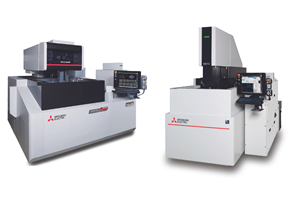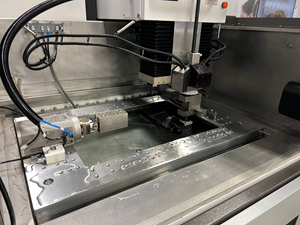Electrode Mill Hits 36,000 RPM
Today's CNC EDMs burn cavities faster than ordinary milling machines can feed them with electrodes, and so the demand for high-speed graphite machining centers has opened up an opportunity that machine-tool builders have begun to fill.
Share






High-speed milling is popping up all over, and a surprising amount of leadership is coming from a narrow and highly focused corner of manufacturing: machining graphite electrodes for EDM (electrical discharge machining). Today's CNC EDMs burn cavities faster than ordinary milling machines can feed them with electrodes, and so the demand for high-speed graphite machining centers has opened up an opportunity that machine-tool builders have begun to fill.
An early entrant in this specialized field, Roku-Roku (available through Vard-Smith Associates, Inc., Midland Park, NJ), has introduced a new 36,000-rpm machine, called the GR435N, which shows how far technology has moved just in this niche. "High-speed" takes on a new flavor at these speeds and some issues which have only minor importance at 15,000 or 20,000 rpm loom large at 36,000.
The first is tool balance. Large metalcutting machining centers running at such speeds have gone to HSK-style tooling because standard ISO/CAT tooling has experienced some trouble holding accuracy in the Z-axis when speeds are very high. But Roku-Roku's new machine sidesteps the potential problem by using small (CAT 20), precision toolholders, which restrict tool diameters to 10 mm. Well-made 20 mm-diameter CAT toolholders stay within their performance envelope, even at 36,000 rpm, this builder finds.
However, small cutters are generally the norm on fine detail and contours, and that's where much of the action is in machining electrodes at really high speed. Most users of EDM who are interested in high-speed electrode making are looking first for higher productivity. But they're also seeking to eliminate benchwork, for two reasons: First is the obvious benefit of eliminating another work-producing step. Second is the increasing demand for geometrical accuracy in finished molds, including parting-line tolerances as tight as 0.0003 inch, or even tighter in some instances. Ultra-precise finish machining is the only reliable way to achieve such accuracies, and following contours at extremely small profiling or contouring step-over increments (0.002 inch or less) demands small cutters.
According to its developers, design of this electrode mill addresses another issue, which spindle-maker Fischer Precision Spindles (an experienced supplier of spindles for high speed milling) calls "high-velocity machining." To take advantage of such high spindle speeds, a machine needs high feed rates—over 300 ipm—and the CNC power to move at such speeds without overrunning corners or breaking tools in fast stop-and-starts. Controllers for these machines must be capable of look-ahead operation to accelerate and decelerate within the tools' limits. In this case,Roku-Roku uses a standard Fanuc 16MC controller with a high-speed RISC-processor accessory to handle look-ahead machining.
Another issue that arises is thermal stability. Machine tool builders are recognizing that structural balance and cooling are necessary to maintain extreme accuracy throughout a working day. The approach that this builder uses is bridge-type construction and oil-cooling in the spindle head, a combination claimed to give the machine an 80 microinch absolute positioning accuracy and 20 microinch repeatability.
These numbers fall into jig-borer territory. For this reason, the GR-435N is built the way jig-borers are built, with hand-fitting of locating surfaces and broad, squat castings. Whether this will be a general characteristic of this emerging class of machines remains to be seen. Some builders are constructing their new electrode-making machines around standard, moderate-sized machining centers. The GR-435N is a departure from this trend, and may be establishing a new threshold with its 36,000-rpm spindle.
Related Content
MC Machinery EDM Offerings Provide Optimized Performance
MC Machinery’s Mitsubishi SG12 and MV2400 EDMs provide ergonomic and efficient operations.
Read MoreHybrid Control Makes Lights-Out EDM More Accessible
This CNC enables EDMs to switch between G-code and an integrated CAM system to adapt to changing conditions and make lights-out manufacturing more attainable.
Read MoreMWI Introduces Wire EDM Consumables Designed to Maximize Energy Efficiency
Blac Technology’s specialized composition is designed to provide uniform distribution and embedding of particles throughout the surface.
Read MoreBelmont Small-Hole EDM Features Multitasking Capabilities
The SY-4060 provides automatic depth control, three-step control of EDM parameters and conversational G- and M-code programming.
Read MoreRead Next
AMRs Are Moving Into Manufacturing: 4 Considerations for Implementation
AMRs can provide a flexible, easy-to-use automation platform so long as manufacturers choose a suitable task and prepare their facilities.
Read MoreMachine Shop MBA
Making Chips and 91ÊÓƵÍøÕ¾ÎÛ are teaming up for a new podcast series called Machine Shop MBA—designed to help manufacturers measure their success against the industry’s best. Through the lens of the Top Shops benchmarking program, the series explores the KPIs that set high-performing shops apart, from machine utilization and first-pass yield to employee engagement and revenue per employee.
Read More



















